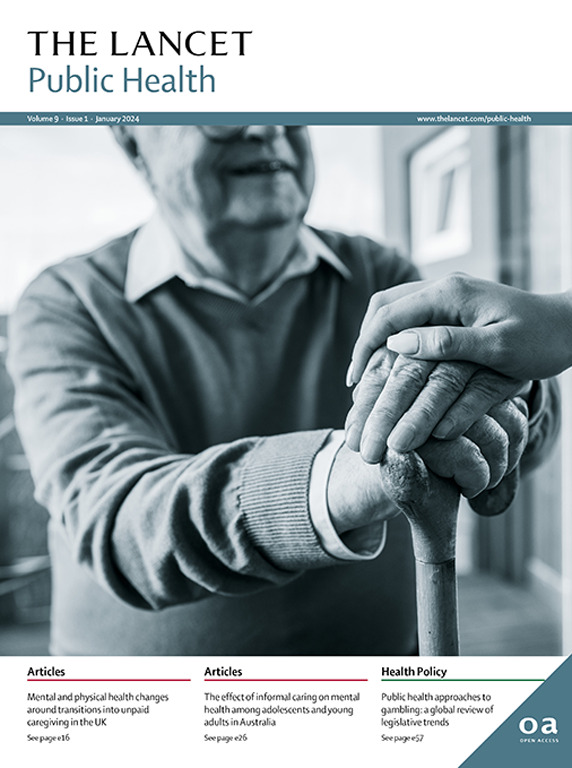Effects of comprehensive smoke-free legislation on smoking behaviours and macroeconomic outcomes in Shanghai, China: a difference-in-differences analysis and modelling study
IF 25.2
1区 医学
Q1 PUBLIC, ENVIRONMENTAL & OCCUPATIONAL HEALTH
引用次数: 0
Abstract
Background
China has one of the highest levels of tobacco consumption globally, and there is no national smoke-free legislation. Although more than 20 Chinese cities have passed local smoke-free laws since 2008, evidence on their effectiveness in reducing smoking behaviours and their economic benefits is scarce. By exploiting a natural quasi-experiment, whereby a comprehensive public smoking ban was implemented in Shanghai in March, 2017, this study aims to assess the impact of the policy on individual smoking behaviours and quantify its effect on macroeconomic outcomes.Methods
In this difference-in-differences analysis and modelling study, we used data on smoking behaviours from the 2012, 2014, 2016, and 2018 waves of the China Family Panel Studies. We used a difference-in-differences approach to investigate trends in smoking prevalence in respondents in Shanghai, relative to respondents from other direct-administered municipalities, provincial capital cities, and subprovincial municipalities (control group), after the implementation of a smoking ban in 2017. All respondents aged 18 years or older were included, with the exception of people who lived in Beijing and rural areas. The primary variable of interest in the difference-in-differences analysis was self-reported smoking status. Based on the difference-in-differences estimation of reduction in smoking prevalence, we then used a health-augmented macroeconomic model to estimate the potential macroeconomic gains if such a ban was implemented across China for the period 2017–35.Findings
14 688 respondents were included in the analysis: 5766 from Shanghai and 8922 from the control group. After the implementation of the smoking ban in Shanghai in 2017, smoking prevalence decreased by 2·2 percentage points (95% CI 2·1–2·3), equivalent to an 8·4% reduction in the number of current smokers. The smoking ban had a larger effect on men, people with a higher level of education, unmarried people, and younger people when compared with their respective counterparts. The modelling analysis showed that implementing a nationwide comprehensive public smoking ban similar to that in Shanghai would result in a 0·04–0·07% increase in the national gross domestic product in China between 2017 and 2035, outweighing the economic costs of smoking ban enforcement.Interpretation
The smoking ban in Shanghai shows that a comprehensive public smoking ban with strict enforcement is effective in curbing smoking behaviours. Moreover, the implementation of a comprehensive public smoking ban across China would be cost-effective.Funding
National Social Science Fund of China.中国上海全面禁烟立法对吸烟行为和宏观经济结果的影响:差异分析和模型研究
背景中国是全球烟草消费水平最高的国家之一,但却没有全国性的无烟立法。尽管自 2008 年以来,中国已有 20 多个城市通过了地方无烟法律,但有关这些法律在减少吸烟行为方面的有效性及其经济效益的证据却很少。2017年3月,上海实施了全面的公共场所禁烟令,本研究利用这一自然准实验,旨在评估该政策对个人吸烟行为的影响,并量化其对宏观经济结果的影响。方法在这项差分分析和建模研究中,我们使用了2012年、2014年、2016年和2018年中国家庭面板研究的吸烟行为数据。我们采用差分法调查了 2017 年禁烟令实施后,上海受访者相对于其他直辖市、省会城市和副省级城市(对照组)受访者的吸烟率趋势。除居住在北京和农村地区的受访者外,所有 18 岁及以上的受访者均被纳入其中。差异分析的主要变量是自我报告的吸烟状况。根据对吸烟率下降的差异估算,我们使用了一个健康增量宏观经济模型,估算了如果在 2017-35 年期间在全国范围内实施禁烟令,可能带来的宏观经济收益。研究结果14 共有 688 名受访者参与分析:其中 5766 人来自上海,8922 人来自对照组。2017 年上海实施禁烟令后,吸烟率下降了 2-2 个百分点(95% CI 2-1-2-3),相当于当前吸烟人数减少了 8-4%。与相应人群相比,禁烟对男性、高学历人群、未婚人群和年轻人的影响更大。模型分析表明,在全国范围内实施与上海类似的公共场所全面禁烟,将使中国在 2017 年至 2035 年间的国民生产总值增长 0-04-0-07%,超过禁烟执法的经济成本。此外,在全国范围内实施全面的公共场所禁烟也是符合成本效益的。
本文章由计算机程序翻译,如有差异,请以英文原文为准。
求助全文
约1分钟内获得全文
求助全文
来源期刊

Lancet Public Health
Medicine-Public Health, Environmental and Occupational Health
CiteScore
55.60
自引率
0.80%
发文量
305
审稿时长
8 weeks
期刊介绍:
The Lancet Public Health is committed to tackling the most pressing issues across all aspects of public health. We have a strong commitment to using science to improve health equity and social justice. In line with the values and vision of The Lancet, we take a broad and inclusive approach to public health and are interested in interdisciplinary research.
We publish a range of content types that can advance public health policies and outcomes. These include Articles, Review, Comment, and Correspondence. Learn more about the types of papers we publish.
 求助内容:
求助内容: 应助结果提醒方式:
应助结果提醒方式:


